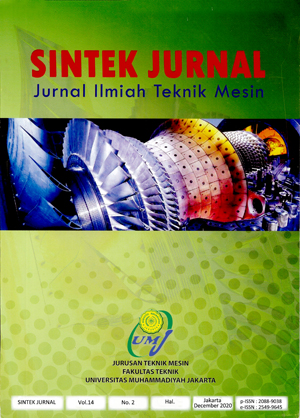LINE BALANCING ANALYSIS BY USED RANK POSITIONAL WEIGHT (RPW) (CASE STUDY: PART BODY S11038Z PROCESS)
Main Article Content
Abstract
Article Details
- Articles published in SINTEK JURNAL are licensed under a Creative Commons Attribution-ShareAlike 4.0 International license. You are free to copy, transform, or redistribute articles for any lawful purpose in any medium, provided you give appropriate credit to the original author(s) and SINTEK JURNAL, link to the license, indicate if changes were made, and redistribute any derivative work under the same license.
- Copyright on articles is retained by the respective author(s), without restrictions. A non-exclusive license is granted to SINTEK JURNAL to publish the article and identify itself as its original publisher, along with the commercial right to include the article in a hardcopy issue for sale to libraries and individuals.
- By publishing in SINTEK JURNAL, authors grant any third party the right to use their article to the extent provided by the Creative Commons Attribution-ShareAlike 4.0 International license.
References
[N. Boysen, M. Fliedner, and A. Scholl, "A classification of assembly line balancing problems," European journal of operational research, vol. 183, pp. 674-693, 2007.
F. Longo, L. Nicoletti, and A. Padovano, "Smart operators in industry 4.0: A human-centered approach to enhance operators’ capabilities and competencies within the new smart factory context," Computers & industrial engineering, vol. 113, pp. 144-159, 2017.
A. T. Schreiber, G. Schreiber, H. Akkermans, A. Anjewierden, N. Shadbolt, R. de Hoog, et al., Knowledge engineering and management: the CommonKADS methodology: MIT press, 2000.
S. C. Leung, S. O. Tsang, W.-L. Ng, and Y. Wu, "A robust optimization model for multi-site production planning problem in an uncertain environment," European journal of operational research, vol. 181, pp. 224-238, 2007.
F. Hendra and R. Effendi, "Identifikasi Penyebab Potensial Kecacatan Produk dan Dampaknya dengan Menggunakan Pendekatan Failure Mode Effect Analysis (FMEA)," SINTEK JURNAL: Jurnal Ilmiah Teknik Mesin, vol. 12, pp. 17-24, 2018.
A. Mukherjee, W. Mitchell, and F. B. Talbot, "The impact of new manufacturing requirements on production line productivity and quality at a focused factory," Journal of Operations Management, vol. 18, pp. 139-168, 2000.
L. Sukarma, F. Hendra, R. Effendi, and E. Mohamad, "The manufacturing technology optimisation model: the crucial contribution of industrial mass-training in improving company performance," in IOP Conference Series: Materials Science and Engineering, 2020, p. 012049.
S. Assauri, "Manajemen Produksi dan Operasi edisi revisi," Jakarta: Lembaga Penerbit Fakultas Ekonomi Universitas Indonesia, 2008.
K. Hitomi, Manufacturing systems engineering: a unified approach to manufacturing technology, production management, and industrial economics: Routledge, 2017.
F. Hendra, R. Ambarita, and K. E. Putranto, "Designing Templates to Support and Monitoring the Activities of Material Requipment Planning (MRP)," in IOP Conference Series: Materials Science and Engineering, 2020, p. 012022.
V. Gaspersz, "Production planning and inventory control," PT Gramedia Pustaka Umum, Jakarta, 2004.
S. T. Ghutukade and S. M. Sawant, "Use of ranked position weighted method for assembly line balancing," Int. J. Adv. Engg. Res. Studies/II/IV/July-Sept, vol. 1, 2013.
J. Heizer and B. Render, "Operations Management (Manajemen Operasi)," Jakarta: Salemba Empat, 2006.
H.-H. Kao, D.-H. Yeh, and Y.-H. Wang, "Resource constrained assembly line balancing problem solved with ranked positional weight rule," Review of Economics & Finance, vol. 1, pp. 71-80, 2011.
M. Hamzas, S. Bareduan, M. Zakaria, S. Ghazali, and S. Zairi, "Implementation of ranked positional weight method (RPWM) for double-sided assembly line balancing problems," in AIP Conference Proceedings, 2017, p. 020183.
T. Baroto, "Perencanaan Line Balaning Guna Meningkatkan Output Produksi," Jurnal Teknik Industri, vol. 2, pp. 109-117, 2010.
Y. Indrawan and N. L. P. Hariastuti, "Minimalisasi bottleneck proses produksi dengan menggunakan metode line balancing," Teknik Industri, Institut Teknologi Adhi Tama, Surabaya, 2013.


